“Maurice, come join us,” they called to him as he passed. Friends with whom I sat beckoned him to our table. Clearly, he recognized them and enjoyed their respect and warm feelings. A slight man with white whiskers and genteel manner, his charming and proper English accent left no doubt as to his British roots and breeding. A youthful 88-years of age, no dodderer he. With an exchange of pleasantries he begged off claiming weariness at day’s end and with goodbyes completed his after dinner departure.
My friends explained that he possessed a wealth of knowledge concerning fine art and antiques. His business focused on the purchase and sale of both. They marveled at the stories he shared. And, oh yes, during his early years in post-WWII England he refurbished and brokered vintage Rolls-Royce automobiles. They affectionately boasted of his encyclopedic knowledge of early Rolls models. Indeed his expertise with the iconic British marquee had earned recognition on both sides of the Atlantic. So much so that by the beginning of the 1970s his renown had drawn the attention of the Rockefeller Estate. Now living in America, Maurice accepted their offer to oversee the vintage car collection of, the now departed, past New York Governor and Vice President Nelson A. Rockefeller.
Shortly after our dinner time introduction, I reached out to Maurice. Indeed he had great stories to tell and this one is a doozy.
Meet Maurice de Montfalcon.
A Silver Ghost story. Real or Fake? You decide.
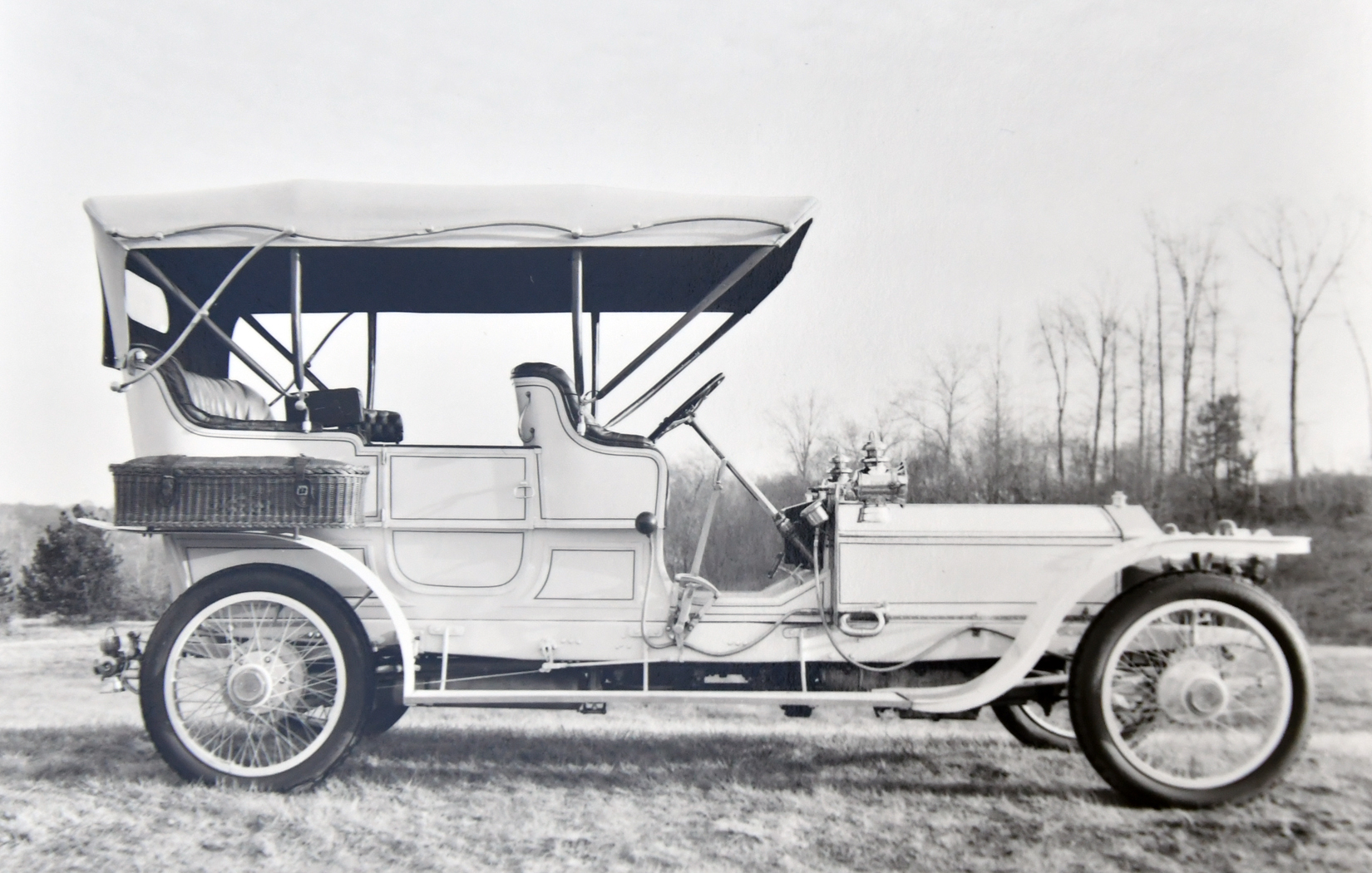
Portrait of the real 60553 by Stephen Salmieri
Upon entering a small but tasteful antique shop in a tony New Jersey suburb, I see owner Maurice de Montfalcon. Exhibiting a frenetic blend of determination and confusion he moves about a room strewn with rare historic documents. All will prove to address the iconic 1907 Rolls-Royce Silver Ghost in general and one specific 1907 Silver Ghost in particular. More about that in a bit. The shop presents itself in a sort of discordant integration of neatly arrayed upmarket collectibles and antiques overlaid by a blizzard of pictures, magazines and papers blanketing every flat surface. The scene recalls photos of Einstein’s office.
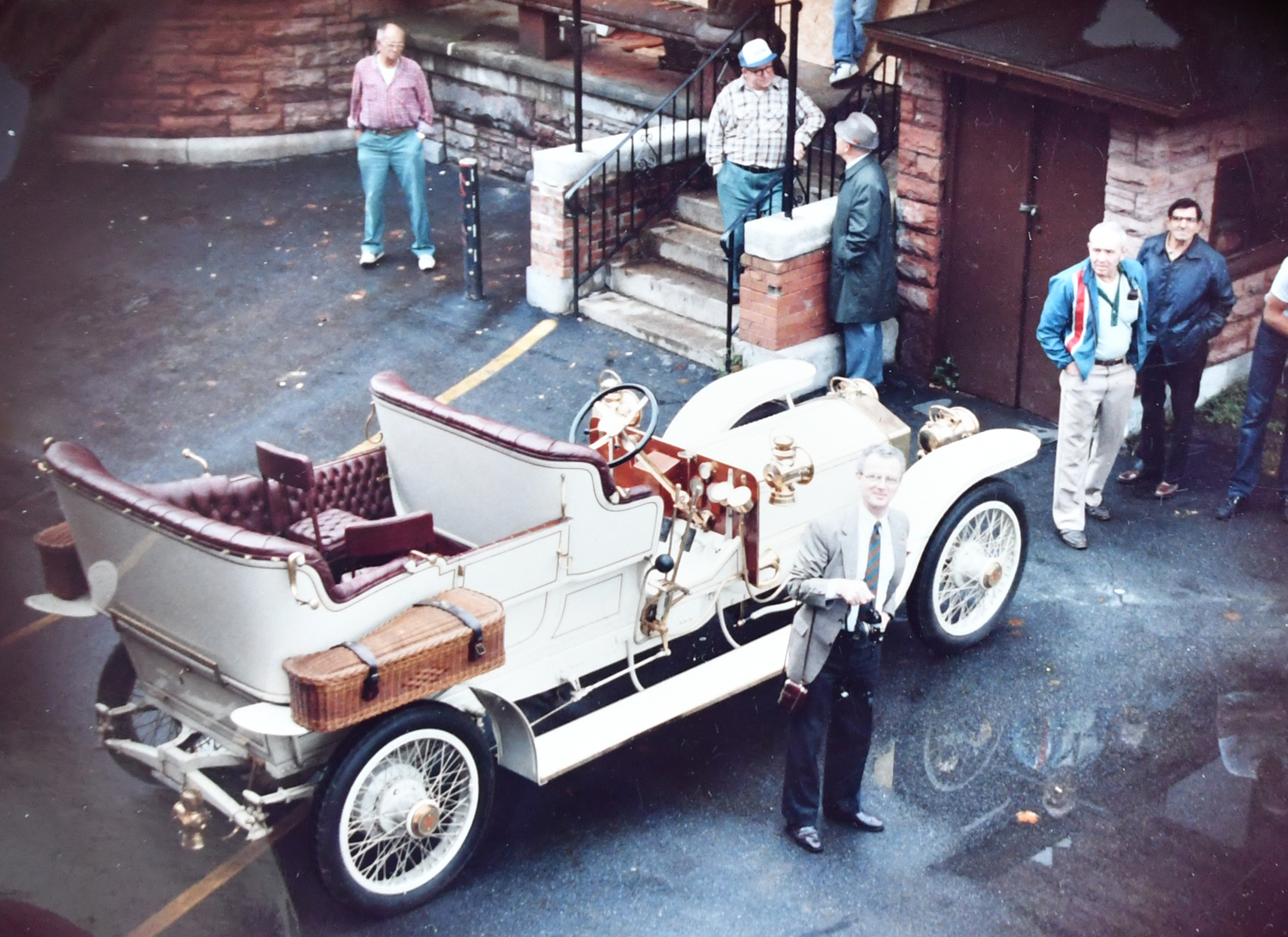
Maurice standing in front of 60553/565, with son (Sam Stevens Jr.) of original owner according to Maurice
Exuding warmth delivered with an air of preoccupation, Maurice, after the briefest of formalities, launches into a breathless description detailing the subject of his apparent obsession. In short order I am grappling with a torrent of historic, legal, and personal detail flooding my brain courtesy of Maurice. It focuses on one 1907 Silver Ghost in particular. Very possibly the first Rolls-Royce to come to America, one once owned by the Rockefeller Estate, as well, once a car for which Maurice had personally cared.
Much the self made man, Maurice, born in 1935, lived through WWII as one of those children shipped en masse on trains departing from London for the countryside to spare them from the relentless Nazi Blitz firebombing. By his early 20s he had been employed in the repair of complex surgical instruments and then sophisticated cameras such as Rolleiflex. Maurice, with classic British reserve recalls saying, “I had a natural ability with mechanical things.” About this time his penchant for Rolls-Royce automobiles blossomed and he began purchasing and refurbishing early 20th century models. Over the next twenty years he worked his way through the labyrinth of the British automotive agency hierarchy to the point that he had achieved a high level of success and recognition from his work associated with Vintage Rolls-Royce models. Quite the stickler for accuracy, his conversations would be sprinkled with the specific chassis numbers of vehicles he would be discussing. Letters he submitted to publications such as MotorSport, would politely school writers on nuanced inaccuracies in their stories involving vintage Rolls-Royces. Self-confident in his knowledge, Maurice prided himself on the accuracy of his professional opinions. He took strong offense at those who challenged his knowledge, honesty and motives.
As the 20th century moved on, the 1970s found Maurice in America. It was at that time that the Rockefeller Estate had reached out to contacts in Britain in search of a person qualified to oversee the classic car collection of Nelson A. Rockefeller with its pre-WWI Rolls-Royces. Maurice came back as the answer. During the period spent overseeing the Rockefeller collection he developed a special affection for a 1907 Silver Ghost, #60553/565, recognized as the first Rolls-Royce delivered to America and a special vehicle of historic importance. He respected it. He cared for it. He drove it. And when the time came in the late 1970s to liquidate the collection he oversaw its sale.
To appreciate the manifest significance of Maurice’s story, if true, requires an appreciation for the importance of provenance, a vehicle’s history. As relates to authenticity, provenance can have a profound impact on a specific vehicle’s historic significance and, thus, its value. A perfect example illustrating the importance and often the difficulty in establishing provenance occurred with the 1952 Cunningham C4R displayed in the prestigious “Winner’s Circle” at the Simeone Museum. Identified as the winner of Sebring in 1953 and a 3rd at LeMans its accomplishments made this specific car historically significant and very valuable. For over sixty-years this car had been recognized by the cognoscenti of automotive racing history as the car that won Sebring, until. Until one day Dr. Fred Simeone, a man of unquestioned integrity and automotive knowledge, noticed that his C4R on display had one more louver on the side than the Sebring winning Cunningham in an old photograph. He recognized that his C4R no longer enjoyed the significance or the value it had before his discovery. Dr. Simeone, though the only person in the world who knew this truth, chose to changed the sign on the display to reflect the discovered truth of its lesser provenance.
If as told to me by Maurice, his story holds water, it would dwarf Dr. Simeone’s discovery and have a far greater impact on the automotive community. It could mean that a Rolls-Royce displayed as an historically important original model could indeed be a replica.

Maurice driving 60553/565 in London early 1980s according to Maurice
Maurice’s story tracks a convoluted tale of provenance. To best understand it requires an appreciation for a few 1907 Rolls-Royce Silver Ghost chassis numbers. Chassis number 60553 belongs to a standard side entrance, Barker bodied Silver Ghost recognized as the first Rolls-Royce delivered to the United States. This makes it a very important and valuable car. Chassis number 60565 belongs to a Rolls-Royce body-less rolling chassis delivered to the same buyer a few months later. In the subsequent telling of Maurice’s story, the first Rolls (the one in the Rockefeller Collection) had its 60553 chassis plate removed during its ownership by the original buyer. Years later the owner affixed the chassis plate from 60565 to 60553 before the sale of 60553. In an attempt to avoid confusion in the telling of Maurice’s story, the chassis number 60553/565 will be used to describe the original 60553 vehicle which in later years would bear the 60565 identification plate from the other car.
As Maurice tells the story, he cared for 60553/565 as part of the Rockefeller Collection knowing its true provenance. In 1979 Maurice placed ads in car magazines promoting the liquidation of the collection. He says, “Then bad things started to happen.” He felt savaged by a letter published in the magazine Old Cars concerning the provenance of the Rockefeller Collection’s 60553/565 by a man, Millard Newman, who claimed that he owned the original 60553. Maurice felt his integrity, knowledge and character had been impugned by a very personal attack. Maurice says, “Newman’s letter took the shape of a personal attack. He wrote ‘”This is a deliberate lie only to enhance the value of the Rockefeller car.” “(Maurice) certainly does not know his Rolls-Royces. I doubt if he has ever seen my car and if he did he apparently did not know what he was looking at.’”
According to Maurice he responded to the letter stating in no uncertain terms that Newman’s car was a fraud. Maurice recalls saying, “That is when the attorney’s letters started coming in promising all types of hell about to rain down on me.” Maurice continues, “They sent all kinds of documents that I was directed to sign recanting my description of the Newman car as a replica.” Actually Maurice emphasizes that he returned every letter basically having written that he would recant nothing.” All hell did not drizzle much less rain. He says, “They did nothing because I was right.” Maurice says, “I had the documentation, letters and photography to prove it.
During that turbulent period Maurice turned his attention away from vintage automobiles as a business to brokering art and antiques as a living. He would do so for the next forty years. Over decades the sting of the Silver Ghost kerfuffle subsided though never vanished. So why now?
What after all these years and at the age of 88 has brought the pain back with such intensity that he wants to write a book to defend his honor, integrity and reputation?
Pain from such events never totally disappears. It resides inside where the body keeps the score. It lurks poised and patiently waiting for a trigger to unleash its fury. Two months ago, after all those years, the discovery of an old letter tripped the trigger. The righteousness of Maurice’s fight for the integrity of the Rockefeller Silver Ghost “his Silver Ghost” returned with a hot vengeance. The letter authored in the 1990s by Samuel B. Stevens the son of the man who originally bought 60553, gave full color clarity to Maurice’s memories and brought bitter indignation to this still unresolved attack on his integrity. Maurice with a nod to inevitability says, “At this point if I die no one will ever know the truth.”
The following provides select pieces of the trail of evidence upon which Maurice stakes his claim to the true fate of 60553.
EARLY AND LATER PHOTOS OF CAR THAT MAURICE SAYS IS A FAKE
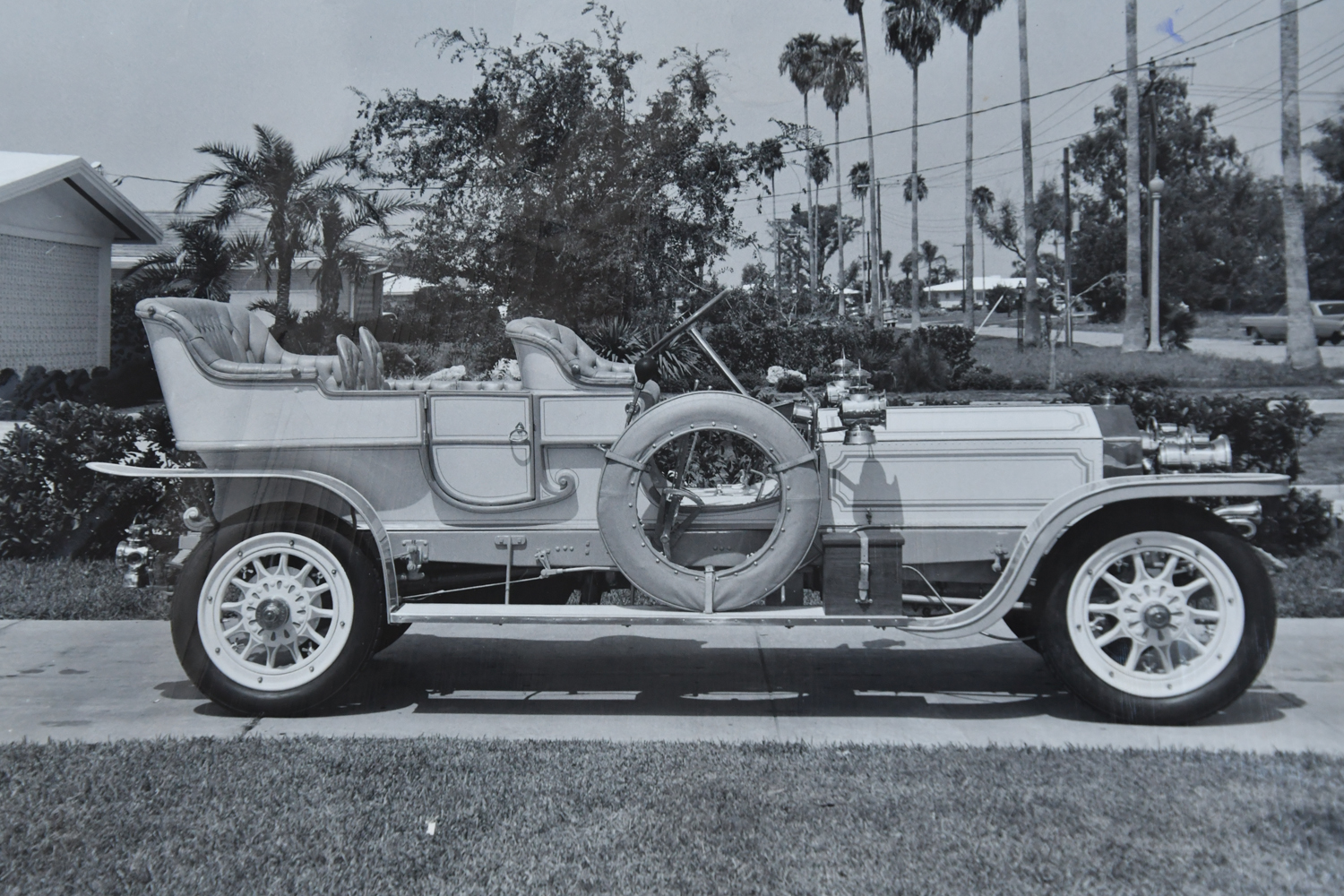
Newman car in restoration. According to Maurice, notice the incorrect distance between rear running board bracket and spring shackle. It is incorrect.
Maurice claims it is a proof of fraud.

According to Maurice a later photo of Newman car with repositioning of rear running board bracket to proper location closer to shackle.
Maurice describes it as the same fraud with new paint.
1979 NEWMAN LETTER
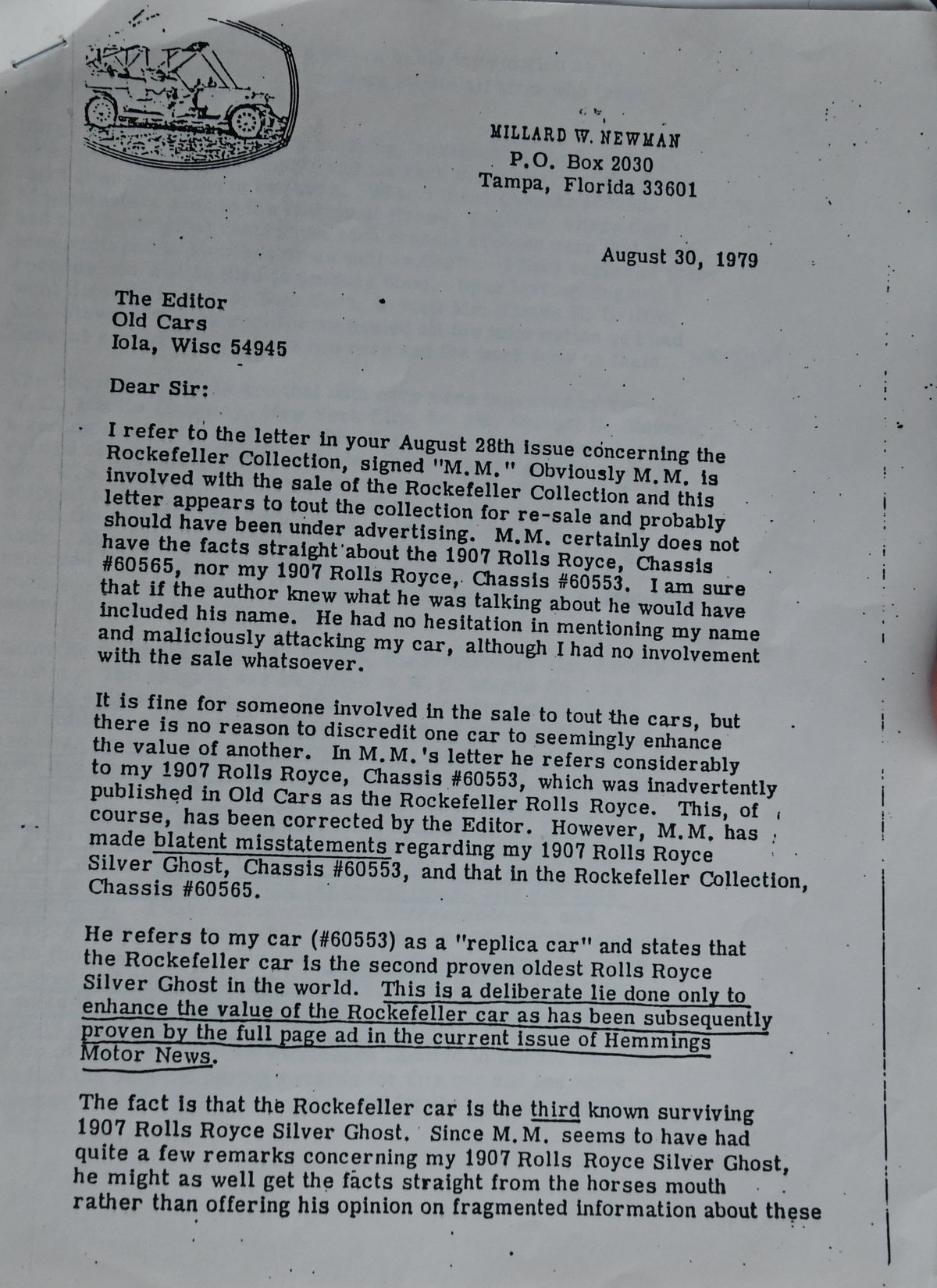
First page of Millard Newman letter to Old Cars in 1979 challenging Maurice’s opinion of Newman’ car
1964 ARTICLE WRITTEN BY WILLARD NEWMAN ON CREATING A REPLICA
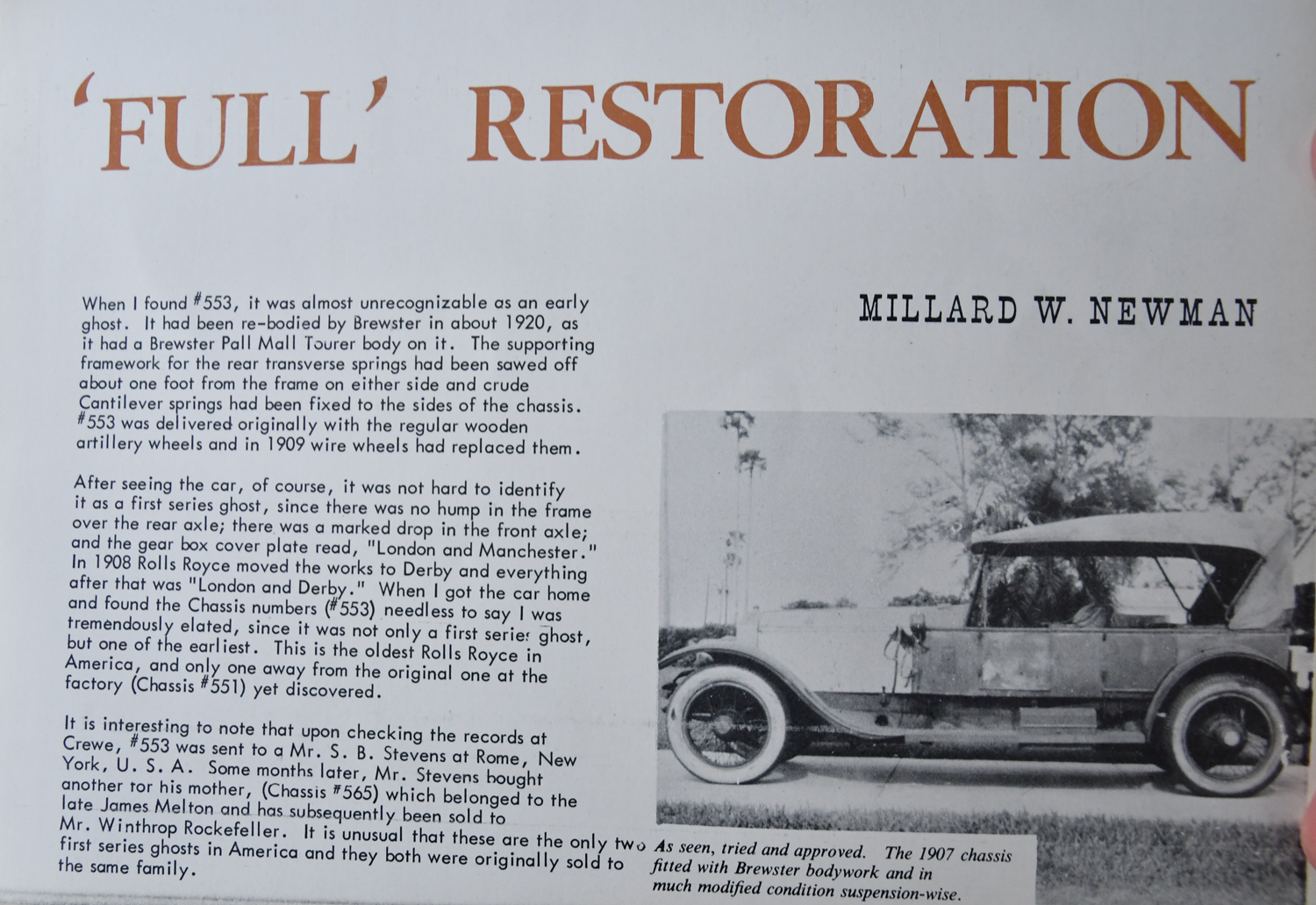
Page 1. Story from 1964 explaining how Willard Newman built a replica.
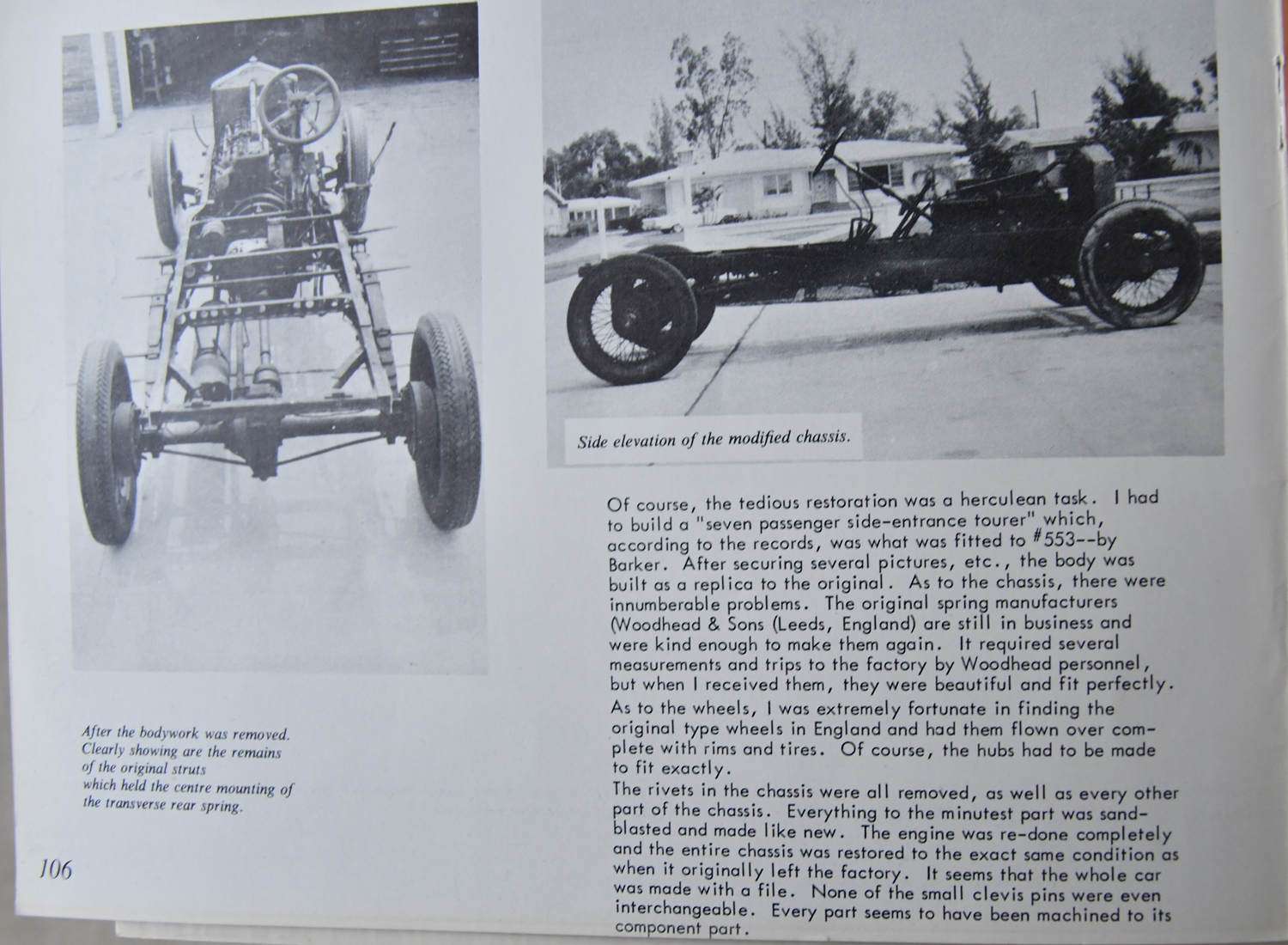
Page 2. Story by Millard Newman from 1964 explaining how he built a replica from a chopped down racing chassis.
LETTER FROM KIRKLAND GIBSON
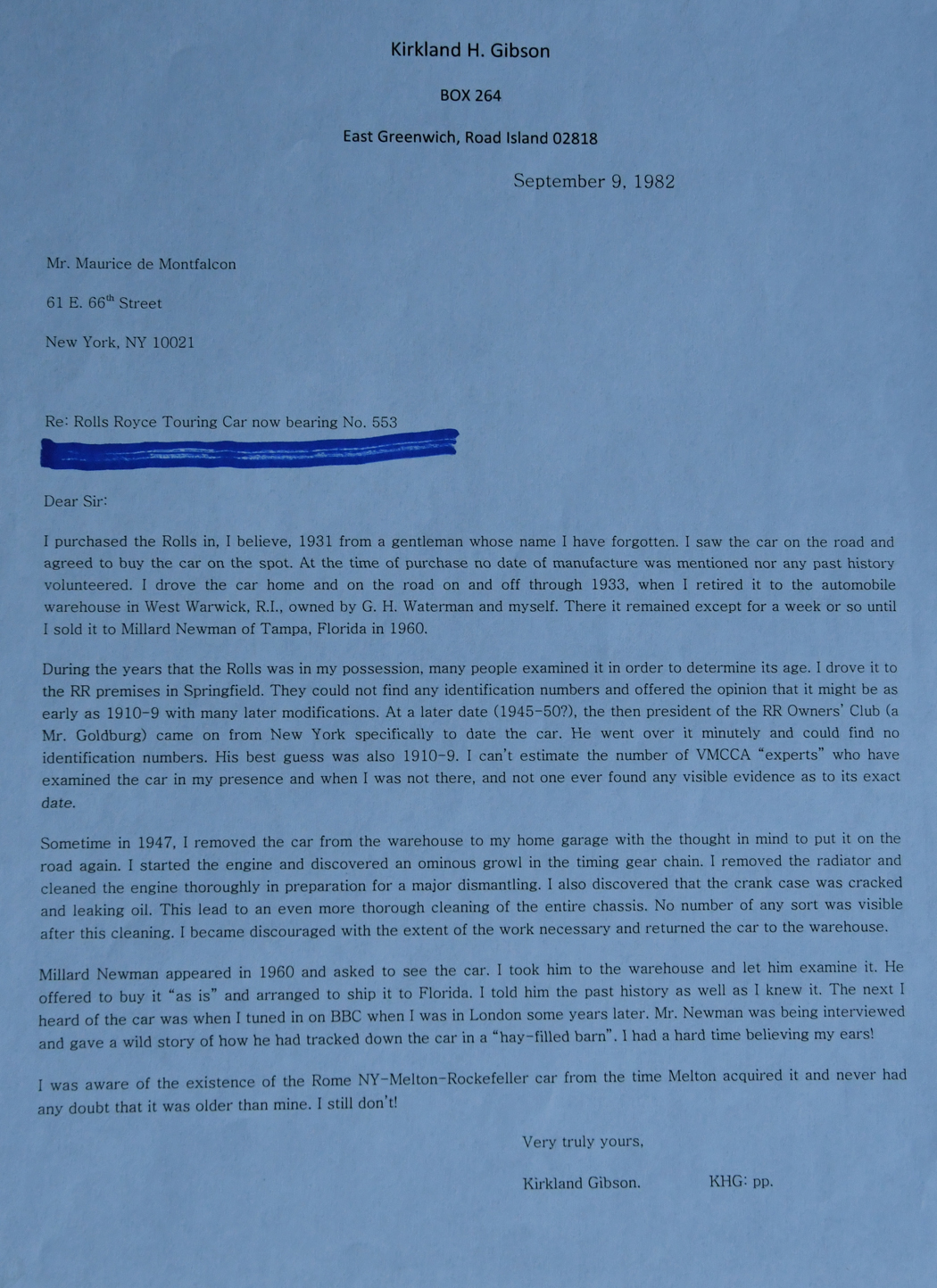
Letter from Kirkland Gibson confirming his sale of a Rolls-Royce to Millard Newman and that it lacked any identification markings and debunks Newman’s story of finding the car in hay-filled barn. As well, Gibson states he had no doubt that the car he sold to Newman was newer than 1907.
LETTER FROM JONATHAN HARLEY
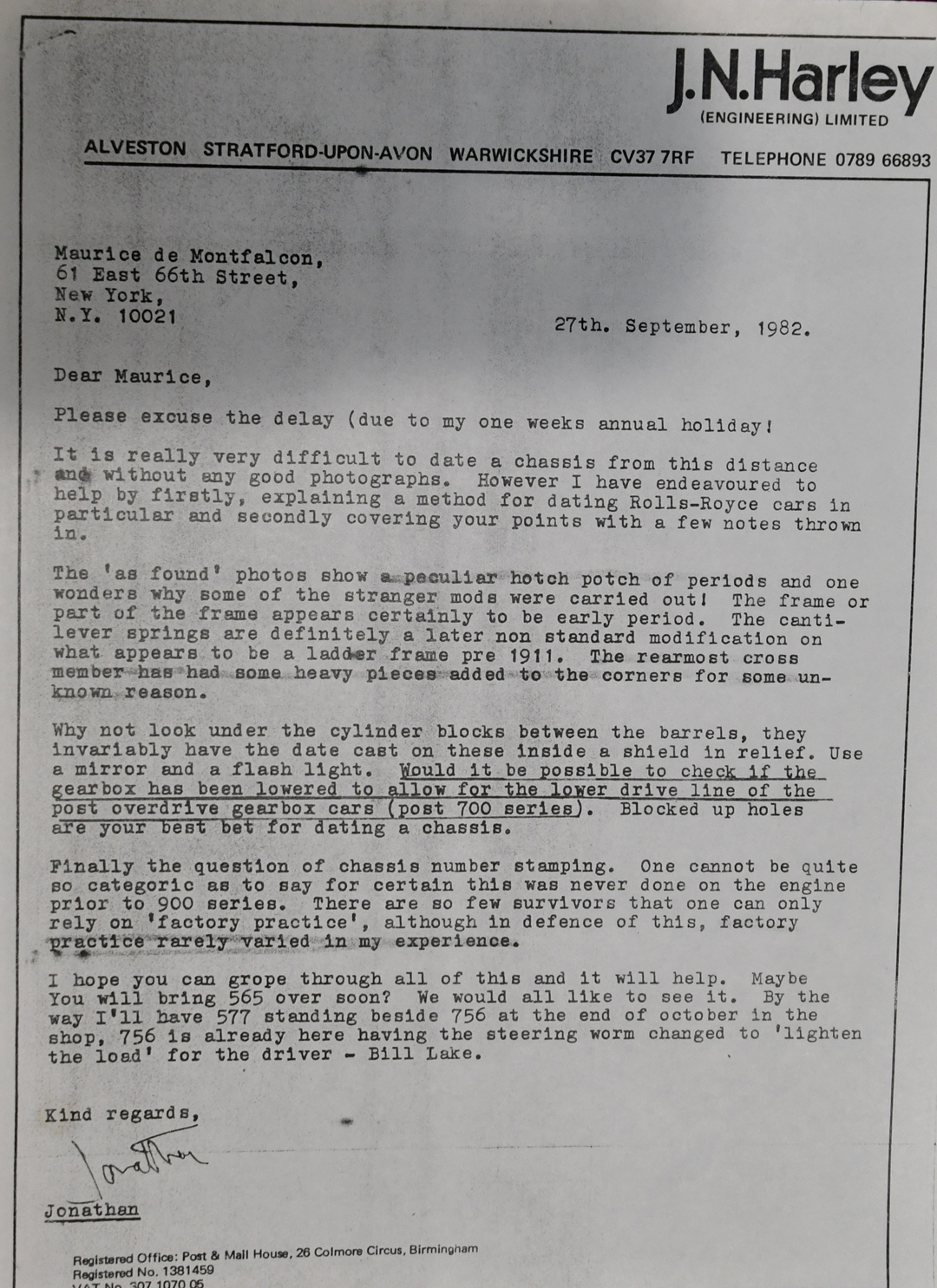
1982 Letter from Jonathon Harley, British Vintage car expert, as explained by Maurice, seriously questioning the authenticity of the chassis sold by Gibson to Newman .
1986 LETTER FROM SAM STEVENS (SON OF ORIGINAL OWNER)

Page 1 of 1986 Letter from original owner’s family confirming early history of 60553 and debunking idea of it as a chopped up race car and suggesting 60565 was scrapped.
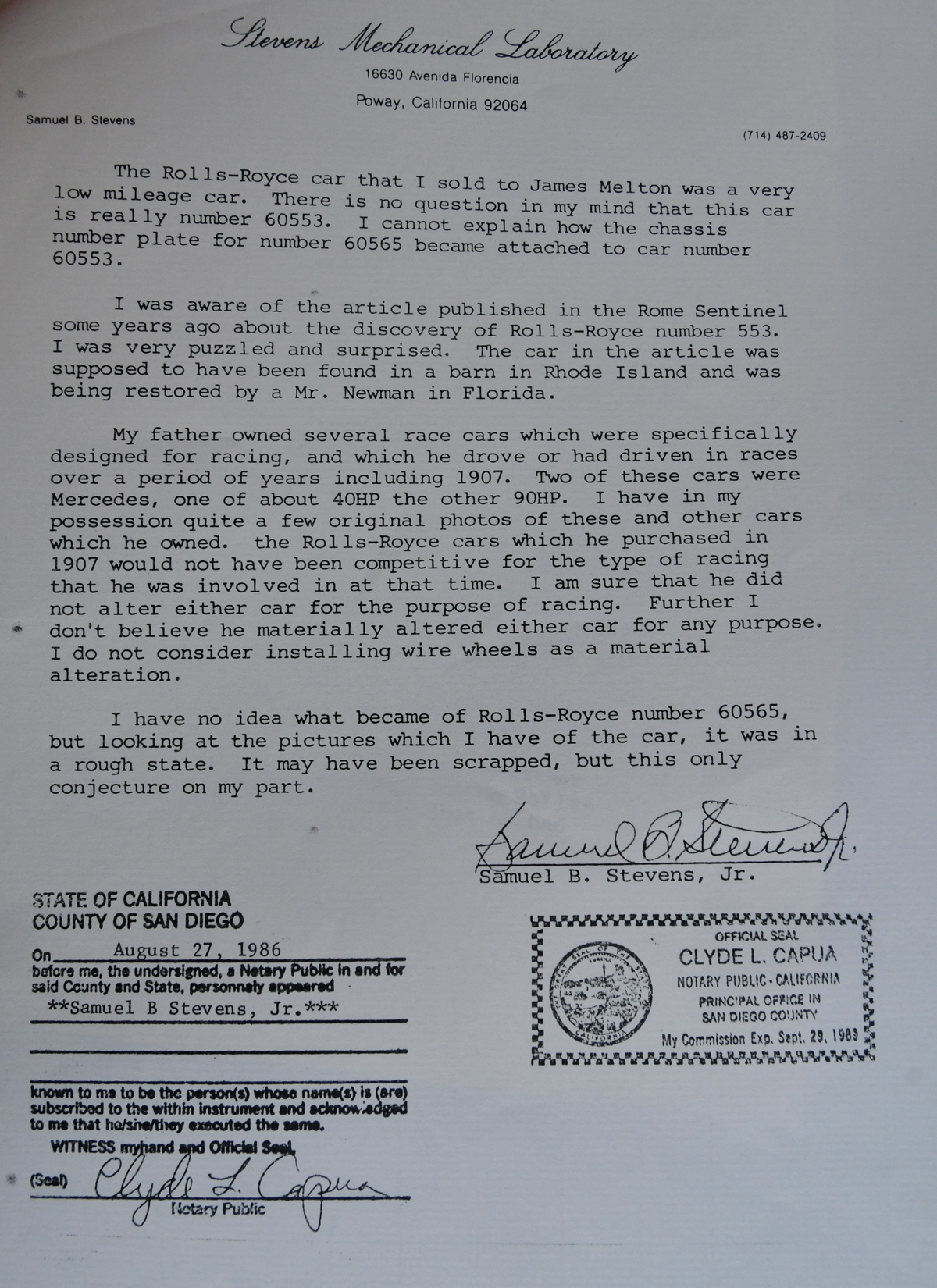
Page 2 of 1986 letter from original owner’s family confirming early history of 60553 and debunking idea of it as a chopped up race car and suggesting 60565 was scrapped.
1996 LETTER FROM SAM STEVENS EXPLAINING WRONG 60565 CHASSIS PLATE ON 60553

1996 letter (fully legible in person) from family of original owner explaining 60565 ID tag on 60553
RETYPED 1996 SAM STEVENS LETTER FOR READABILITY
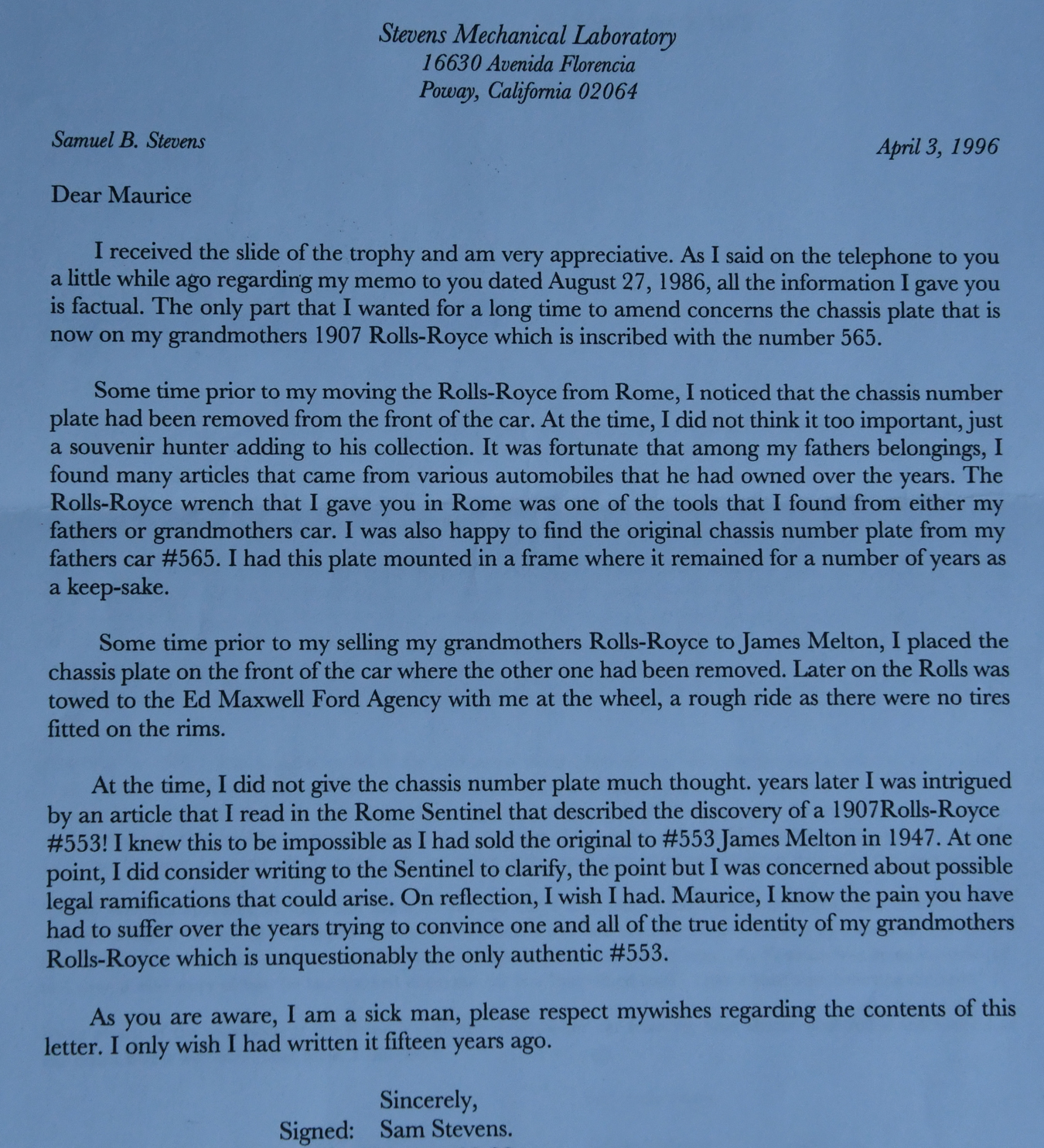
1990 SOTHEBY’S CATALOG
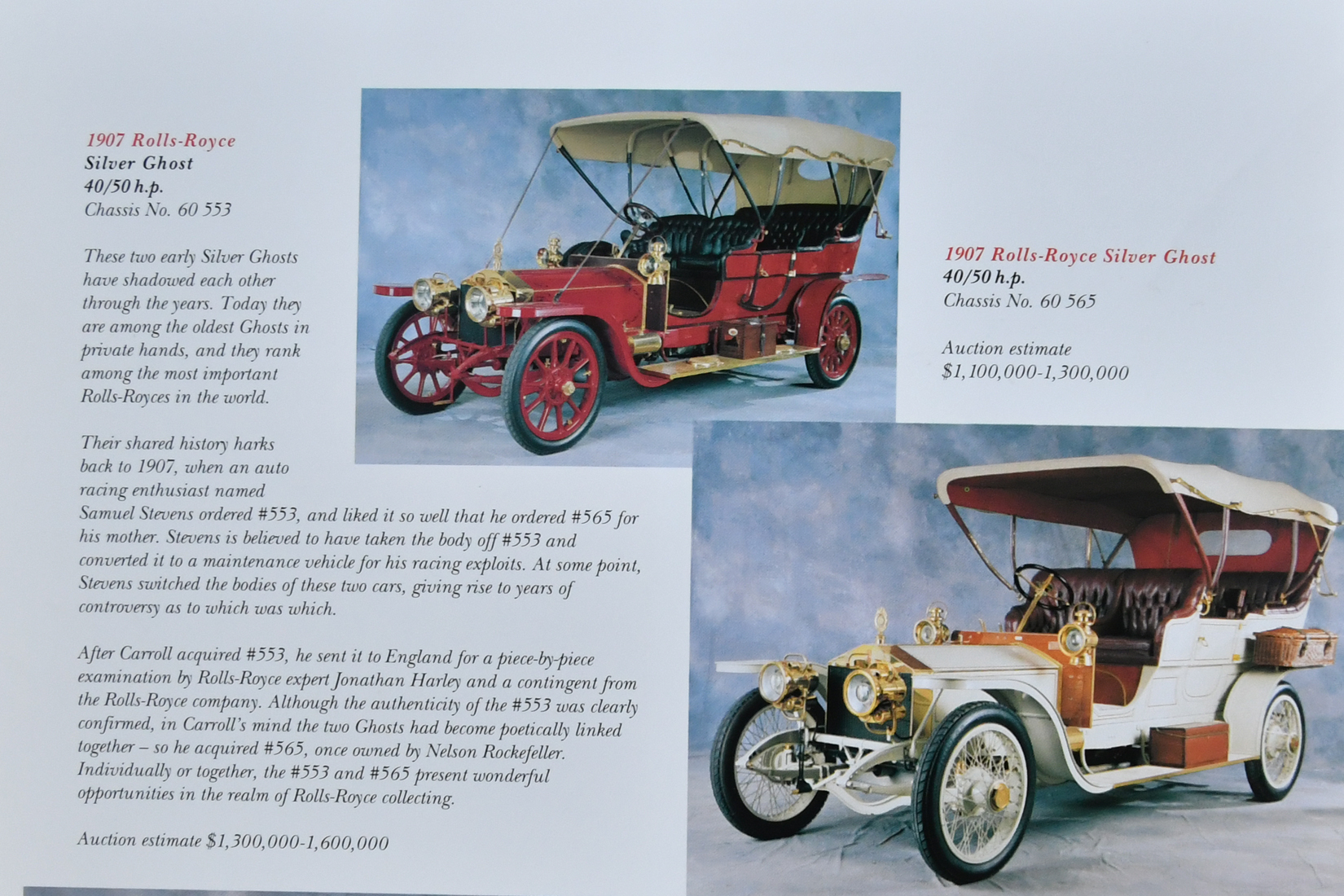
1990 Sotheby’s catalogue, which according to Maurice, misidentified 60553 and 60565. Maurice states that the red car is a fake and that the white car is the actual 60533 with the wrong chassis plate
Interestingly in 1990 Sotheby’s auctioned two 1907 Rolls- Royce Silver Ghosts believed to be 60553 and 60565. One identified as 60565 went for $2.8 million the most for a Rolls-Royce up to that time and the alleged 60533, depending on whether you believe Maurice or not, went for $2.05 million
So you decide. Which is the real 60553?
If you believe that Millard Newman found the real 60553 in a hay-filled barn, then the car sold at Sotheby’s in 1990 is 60553 and the first new Rolls-Royce delivered to America. Today, that Silver Ghost stands on display at the respected Peterson Museum.
But what if the case presented by Maurice is true? Then the car sitting in the Petersen would be a replica and whoever owns 60565 would actually own the first Rolls-Royce in America wearing the wrong chassis plate.
Who thought provenance could be so dramatic, suspenseful and exciting? Other than Maurice that is.

Talk about intrigue. This is a fascinating story, extremely well researched and presented!
Mr. de Montfalcon offered a wealth of information and is a real gentleman.
Wow, what a story!! A good read!
Appreciate your comments.
I am highly indebted to Burton Hall, for his professionally written approach to this unsavory saga, regarding the most important, and first 1907 Rolls-Royce 40/50 hp Silver Ghost, chassis number 60-553 to be delivered new in the U.S.A. Also, the extraordinary fact that its lineage, is verifiably traceable, from its first delivery date of c. April, 07. via the Rolls-Royce agents, Martins at Broadway, N.Y. to Samuel B. Stevens its first owner, in early 1907! Possibly a simple blurb, in the suburban Newspaper, The Daily Sentinel, of Rome New York, coupled with a picture, of the late owner Samuel B. Stevens 1907 Rolls-Royce 40/50 hp Barker Tourer 60-553, complete with Tireless Wheels, but publicly forgotten, taken in the Ed Maxwell Ford Agency on June 1, 1946 where it had been stored by Samuel B. Stevens Jr. since circa 1940, Which proves that this particular Rolls-Royce #60553, is the only Authentic one, and the other, c.1907 Rolls-Royce Replica, now bearing #60553, must be the Imposter!
Your comments are quite kind. You offer a vast wealth of quality information and passion.